Submitted:
19 December 2023
Posted:
20 December 2023
You are already at the latest version
Abstract
Keywords:
1. Introduction
2. Results
2.1. Physicochemical Variables
2.2. Trophic State
2.3. Biological Variables
2.4. Statistical Processing
3. Discussion
4. Study Site and Methods
4.1. Study Site
4.2. Physicochemical Variables
4.3. Biological Variables
4.4. Statistical Processing
Acknowledgments
Data Availability Statement
Conflicts of Interest
Appendix A
| Reservoir | Year | Secchi | Clorophyll | Dc | Dc | Dnc | Cc | Cnc | Chc | Chnc | Cia | Cr | D | Vc |
|---|---|---|---|---|---|---|---|---|---|---|---|---|---|---|
| ALB | 12,14,15 | 3,20 | 3,18 | 1 | 0 | 2 | 2 | 2 | 3 | 3 | 4 | 2 | 1 | 0 |
| ALL | 10,13,15 | 3,23 | 1,79 | 0 | 0 | 3 | 1 | 1 | 2 | 4 | 4 | 2 | 1 | 1 |
| ARD | 10,12 | 0,55 | 1,09 | 0 | 0 | 2 | 0 | 1 | 1 | 1 | 0 | 2 | 0 | 0 |
| BAL | 11,12,14,15 | 2,41 | 2,99 | 5 | 2 | 2 | 1 | 1 | 1 | 2 | 1 | 3 | 1 | 2 |
| BAR | 10,11,12,14 | 4,03 | 2,89 | 0 | 0 | 3 | 2 | 2 | 2 | 2 | 2 | 2 | 1 | 1 |
| BAS | 13,14 | 11,70 | 1,32 | 2 | 1 | 2 | 1 | 3 | 1 | 1 | 2 | 2 | 1 | 0 |
| BUB | 13,15 | 6,40 | 2,07 | 3 | 2 | 2 | 1 | 1 | 0 | 2 | 0 | 3 | 1 | 0 |
| CAL | 10,11,12,14 | 4,04 | 1,41 | 4 | 2 | 3 | 2 | 1 | 1 | 2 | 2 | 2 | 1 | 0 |
| CAM | 11,14 | 5,10 | 1,77 | 4 | 2 | 2 | 1 | 2 | 1 | 3 | 2 | 3 | 1 | 0 |
| CAN | 13 | 4,00 | 1,83 | 4 | 2 | 3 | 3 | 1 | 0 | 2 | 3 | 3 | 1 | 0 |
| CAS | 10,11,12,14,15 | 3,68 | 4,13 | 1 | 1 | 3 | 2 | 1 | 1 | 4 | 5 | 2 | 1 | 1 |
| CAV | 15 | 18,00 | 0,71 | 0 | 0 | 0 | 1 | 1 | 0 | 3 | 0 | 2 | 1 | 0 |
| CER | 11,12 | 1,23 | 7,01 | 4 | 2 | 2 | 0 | 0 | 1 | 3 | 4 | 3 | 0 | 0 |
| CIU | 11,12,14 | 6,17 | 1,08 | 2 | 1 | 2 | 2 | 2 | 1 | 3 | 1 | 2 | 1 | 1 |
| COR | 11,12 | 1,25 | 2,17 | 4 | 2 | 2 | 0 | 0 | 1 | 2 | 0 | 2 | 0 | 0 |
| CUE | 10,11,12,13,14,15 | 2,97 | 4,72 | 0 | 0 | 3 | 0 | 1 | 1 | 4 | 4 | 3 | 1 | 2 |
| EBR | 10,11,12,13,14,15 | 3,43 | 4,67 | 6 | 3 | 2 | 2 | 1 | 2 | 2 | 4 | 3 | 1 | 0 |
| ESC | 13 | 6,80 | 2,57 | 4 | 2 | 3 | 0 | 2 | 0 | 2 | 0 | 3 | 1 | 0 |
| ESR | 15 | 5,70 | 1,14 | 2 | 1 | 2 | 0 | 1 | 0 | 1 | 0 | 1 | 1 | 0 |
| EST | 15 | 1,30 | 3,31 | 0 | 0 | 2 | 2 | 0 | 1 | 4 | 2 | 2 | 0 | 0 |
| EUG | 11,13 | 5,55 | 2,26 | 3 | 1 | 2 | 2 | 1 | 0 | 2 | 0 | 2 | 0 | 0 |
| FLI | 10,11,12,14,15 | 4,57 | 1,30 | 4 | 2 | 2 | 0 | 0 | 1 | 2 | 3 | 2 | 0 | 0 |
| GAL | 10,11,12,13,14 | 2,85 | 3,34 | 0 | 0 | 3 | 0 | 1 | 2 | 3 | 2 | 2 | 0 | 2 |
| GRA | 13 | 7,30 | 1,22 | 1 | 1 | 2 | 0 | 1 | 0 | 1 | 0 | 1 | 0 | 0 |
| GUI | 10,11,12,13,14,15 | 2,63 | 4,66 | 3 | 1 | 3 | 2 | 1 | 3 | 3 | 4 | 3 | 1 | 1 |
| IRA | 12,14,15 | 5,17 | 2,29 | 2 | 1 | 3 | 3 | 1 | 1 | 2 | 0 | 2 | 1 | 0 |
| ITO | 11,13 | 5,30 | 0,95 | 2 | 1 | 2 | 2 | 2 | 2 | 2 | 3 | 2 | 1 | 0 |
| LAN | 13,15 | 5,98 | 1,26 | 3 | 1 | 2 | 1 | 2 | 0 | 3 | 0 | 3 | 1 | 0 |
| LEC | 10,11,12,13,15 | 3,99 | 5,42 | 0 | 0 | 2 | 0 | 1 | 2 | 4 | 1 | 3 | 2 | 0 |
| LLA | 15 | 17,00 | 0,54 | 5 | 2 | 2 | 1 | 2 | 0 | 2 | 0 | 2 | 1 | 0 |
| LOT | 11,12,13,14 | 1,53 | 4,94 | 0 | 0 | 3 | 0 | 0 | 2 | 3 | 2 | 3 | 1 | 0 |
| MAE | 14,15 | 1,55 | 6,70 | 1 | 1 | 4 | 2 | 2 | 1 | 3 | 3 | 3 | 1 | 1 |
| MAN | 10,13 | 4,80 | 2,66 | 6 | 2 | 2 | 2 | 0 | 0 | 3 | 2 | 3 | 0 | 2 |
| MAR | 12,13,14,15 | 2,57 | 3,39 | 1 | 0 | 2 | 2 | 2 | 3 | 4 | 3 | 3 | 1 | 1 |
| MED | 13 | 2,80 | 1,84 | 2 | 1 | 3 | 2 | 2 | 0 | 1 | 0 | 3 | 1 | 0 |
| MEQ | 10,11,12,13,14,15 | 4,25 | 3,99 | 4 | 2 | 3 | 0 | 2 | 2 | 3 | 4 | 3 | 1 | 2 |
| MEZ | 11,13,14,15 | 2,13 | 4,32 | 0 | 0 | 2 | 0 | 1 | 2 | 3 | 2 | 3 | 1 | 1 |
| MOA | 12,14 | 3,33 | 2,43 | 1 | 0 | 2 | 2 | 2 | 1 | 3 | 2 | 2 | 1 | 0 |
| MON | 11,12,14,15 | 1,45 | 2,12 | 1 | 1 | 3 | 0 | 2 | 1 | 3 | 1 | 2 | 0 | 1 |
| MOV | 12,13 | 2,10 | 1,73 | 0 | 0 | 1 | 0 | 0 | 1 | 1 | 1 | 2 | 0 | 1 |
| OLI | 10,11,12,14,15 | 2,57 | 7,92 | 6 | 2 | 2 | 0 | 3 | 2 | 3 | 4 | 3 | 1 | 2 |
| ORT | 10,13 | 6,88 | 2,70 | 2 | 1 | 1 | 1 | 2 | 1 | 2 | 0 | 3 | 1 | 0 |
| PAJ | 10,11,14 | 5,13 | 2,33 | 3 | 1 | 1 | 1 | 1 | 1 | 3 | 3 | 2 | 1 | 0 |
| PEN | 10,13 | 4,11 | 1,82 | 1 | 1 | 3 | 2 | 2 | 1 | 2 | 2 | 2 | 1 | 0 |
| PEÑ | 10,12,13,14,15 | 1,12 | 3,96 | 0 | 0 | 2 | 3 | 3 | 1 | 2 | 0 | 3 | 1 | 0 |
| PUE | 12 | 2,55 | 2,03 | 4 | 2 | 1 | 0 | 0 | 1 | 1 | 0 | 3 | 0 | 2 |
| RIA | 10,11,12,13,14,15 | 2,56 | 5,20 | 4 | 2 | 3 | 0 | 2 | 2 | 4 | 4 | 3 | 1 | 0 |
| RIB | 10,11,12,14,15 | 3,14 | 10,24 | 7 | 3 | 3 | 0 | 1 | 2 | 3 | 4 | 3 | 1 | 1 |
| SAB | 13 | 2,60 | 0,01 | 0 | 0 | 2 | 0 | 0 | 0 | 0 | 2 | 0 | 0 | 0 |
| SAN | 10,11,14 | 3,84 | 1,58 | 2 | 1 | 2 | 2 | 2 | 1 | 2 | 1 | 2 | 1 | 1 |
| SLO | 10,14,15 | 2,03 | 2,68 | 5 | 2 | 3 | 2 | 1 | 1 | 2 | 2 | 2 | 1 | 2 |
| SOB | 10,11,12,13,14,15 | 2,75 | 6,81 | 5 | 2 | 3 | 1 | 1 | 2 | 2 | 2 | 3 | 1 | 2 |
| SOP | 15 | 4,25 | 0,40 | 4 | 2 | 2 | 0 | 0 | 0 | 1 | 0 | 1 | 0 | 0 |
| SOT | 10,11,13,15 | 2,54 | 2,81 | 3 | 1 | 2 | 2 | 1 | 1 | 3 | 0 | 2 | 1 | 1 |
| STO | 10,13 | 5,93 | 1,21 | 3 | 1 | 2 | 0 | 1 | 1 | 2 | 2 | 2 | 1 | 1 |
| TAL | 13 | 3,22 | 4,07 | 5 | 2 | 3 | 0 | 0 | 1 | 3 | 2 | 3 | 1 | 1 |
| TER | 10,12,14,15 | 0,79 | 2,07 | 3 | 1 | 2 | 2 | 1 | 0 | 1 | 1 | 2 | 1 | 0 |
| TOR | 10,11,13 | 4,33 | 2,42 | 2 | 1 | 3 | 2 | 1 | 1 | 2 | 1 | 3 | 1 | 0 |
| TRA | 10,12,13,14,15 | 3,31 | 10,62 | 2 | 1 | 3 | 1 | 1 | 2 | 4 | 4 | 3 | 2 | 1 |
| ULL | 10,12,13 | 5,10 | 3,29 | 5 | 2 | 2 | 1 | 2 | 1 | 2 | 3 | 3 | 1 | 1 |
| URD | 15 | 5,80 | 1,59 | 0 | 0 | 2 | 1 | 2 | 0 | 2 | 0 | 2 | 1 | 0 |
| URR | 10,11,12,13 | 5,11 | 2,48 | 5 | 2 | 2 | 1 | 2 | 1 | 2 | 3 | 3 | 0 | 1 |
| UTC | 12 | 0,98 | 9,71 | 5 | 2 | 3 | 0 | 2 | 2 | 3 | 3 | 3 | 0 | 0 |
| VAD | 10,14 | 0,70 | 6,05 | 5 | 1 | 2 | 0 | 0 | 1 | 2 | 2 | 2 | 0 | 0 |
| VAL | 11,12,13,14,15 | 5,20 | 2,51 | 0 | 2 | 3 | 3 | 2 | 0 | 1 | 2 | 2 | 1 | 1 |
| YES | 10,14,15 | 1,38 | 19,81 | 2 | 0 | 3 | 0 | 2 | 3 | 4 | 4 | 3 | 1 | 0 |
References
- Reynolds, C.S.; Irish, A.E. Modelling Phytoplankton Dynamics in Lakes and Reservoirs: The Problem of in-Situ Growth Rates. Hydrobiologia 1997, 349, 5–17. [CrossRef]
- Jones, V.J. The Diversity, Distribution and Ecology of Diatoms from Antarctic Inland Waters. Biodiversity & Conservation 1996, 5, 1433–1449. [CrossRef]
- Salmaso, N.; Naselli-Flores, L.; Padisák, J. Functional Classifications and Their Application in Phytoplankton Ecology. Freshwater Biology 2015, 60, 603–619. [CrossRef]
- Descy, J.-P.; Gosselain, V. Development and Ecological Importance of Phytoplankton in a Large Lowland River (River Meuse, Belgium). Phytoplankton in Turbid Environments: Rivers and Shallow Lakes 1994, 139–155. [CrossRef]
- Soria, J.M.; Montagud, D.; Sòria-Perpinyà, X.; Dolores Sendra, M.; Vicente, E. Phytoplankton Reservoir Trophic Index (PRTI): A New Tool for Ecological Quality Studies. Inland Waters 2019, 9, 301–308. [CrossRef]
- de Jonge, V.N.; Elliott, M.; Orive, E. Causes, Historical Development, Effects and Future Challenges of a Common Environmental Problem: Eutrophication. Nutrients and Eutrophication in Estuaries and Coastal Waters 2002, 1–19. [CrossRef]
- Barbe, J.; Lafont, M.; Mallet, L.; Mouthon, J.; Philippe, M.; Vey, V. Actualisation de La Méthode de Diagnose Rapide Des Plans d’eau Analyse Critique Des Indices de Qualité Des Lacs et Propositions d’indices de Fonctionnement de l’écosystème Lacustre. CEMAGREF, France 2003.
- Viviroli, D.; Archer, D.R.; Buytaert, W.; Fowler, H.J.; Greenwood, G.B.; Hamlet, A.F.; Huang, Y.; Koboltschnig, G.; Litaor, M.I.; López-Moreno, J.I.; et al. Climate Change and Mountain Water Resources: Overview and Recommendations for Research, Management and Policy. Hydrology and Earth System Sciences 2011, 15, 471–504. [CrossRef]
- Navarro, E.; Caputo, L.; Marcé, R.; Carol, J.; Benejam, L.; García-Berthou, E.; Armengol, J. Ecological classification of a set of Mediterranean reservoirs applying the EU Water Framework Directive: A reasonable compromise between science and management. Lake and Reservoir Management 2009, 25(4), 364-376. [CrossRef]
- Predictive Capability of U.S. OECD Phosphorus Loading-Eutrophication Response Models on JSTOR Available online: https://www.jstor.org/stable/25042007#metadata_info_tab_contents (accessed on 27 July 2022).
- Hoyos, C.; Catalan, J.; Dörflinger, G.; Ferreira, J.; Kemitzoglou, D. et al.. Water Framework Directive Intercalibration Technical Report: Mediterranean Lake Phytoplankton ecological assessment methods. Publications Office of the European Union, Scientific and Technical Research series, 2014, 65pp.
- Romero, J.R.; Antenucci, J.P.; Imberger, J. One- and Three-Dimensional Biogeochemical Simulations of Two Differing Reservoirs. Ecological Modelling 2004, 174, 143–160. [CrossRef]
- García-Berthou, E. Ramon Margalef, l’estany de Banyoles i Els Peixos. 2020.
- Rychtecky, P.; Rychtecky, R.; Znachor, P. Spatial Heterogeneity and Seasonal Succession of Phytoplankton along the Longitudinal Gradient in a Eutrophic Reservoir. Hydrobiologia 2011, 663(1), 175-186. [CrossRef]
- Dasí, M.J.; Miracle, M.R.; Camacho, A.; Soria, J.M.; Vicente, E. Summer Phytoplankton Assemblages across Trophic Gradients in Hard-Water Reservoirs. Hydrobiologia 1998, 369–370, 27–43. [CrossRef]
- Hoyos, C.; Negro, A.I.; Aldasoro-Martin, J.J. Cyanobacteria Distribution and Abundance in the Spanish Water Reservoirs during Thermal Stratification. Limnetica 2004, 23(1-2), 119-132.
- Jorgensen, S.E. The application of models to find the relevance of residence time in lake and reservoir management. Journal of Limnology 2003, 62(1s), 16-20.
- Gemelgo, M.C.P.; Mucci, J.L.N.; Navas-Pereira, D. Population dynamics: seasonal variation of phytoplankton functional groups in Brazilian reservoirs (Billings and Guarapiranga, São Paulo). Brazilian Journal of Biology 2009, 69, 1001-1013..
- Antoniades, D.; Michelutti, N.; Quinlan, R.; Blais, J.M.; Bonilla, S.; Douglas, M.S.V.; Pienitz, R.; Smol, J.P.; Vincenta, W.F. Cultural Eutrophication, Anoxia, and Ecosystem Recovery in Meretta Lake, High Arctic Canada. Limnology and Oceanography 2011, 56, 639–650. [CrossRef]
- Menzel, P.; Gaye, B.; Wiesner, M.G.; Prasad, S.; Stebich, M.; Das, B.K.; Anoop, A.; Riedel, N.; Basavaiah, N. Influence of Bottom Water Anoxia on Nitrogen Isotopic Ratios and Amino Acid Contributions of Recent Sediments from Small Eutrophic Lonar Lake, Central India. Limnology and Oceanography 2013, 58, 1061–1074. [CrossRef]
- Marchetto, A.; Padedda, B.M.; Mariani, M.A.; Lugliè, A.; Sechi, N. A Numerical Index for Evaluating Phytoplankton Response to Changes in Nutrient Levels in Deep Mediterranean Reservoirs. J. Limnol. 2009, 68, 106–121.
- Soria, J.M.; Montagud, D.; Sòria-Perpinyà, X.; Dolores Sendra, M.; Vicente, E. Phytoplankton Reservoir Trophic Index (PRTI): A New Tool for Ecological Quality Studies. Inland Waters 2019, 9, 301–308. [CrossRef]
- Spanish Government. M-LE-FP-2013 Protocolo de muestreo de fitoplancton en lagos y embalses (in Spanish). 2013, 18 pp. Available online: https://www.miteco.gob.es/es/agua/temas/estado-y-calidad-de-las-aguas/M-LE-FP-2013_Muestreo_Fitoplancton_Lagos%20y%20embalses_05_06_2013_tcm30-175286.pdf (accessed on 28 July 2022).
- American Public Health Association. Standard Methods for the Examination of Water & Wastewater. 2005, 1200.
- Verdouw, H.; van Echteld, C.J.A.; Dekkers, E.M.J. Ammonia Determination Based on Indophenol Formation with Sodium Salicylate. Water Research 1978, 12, 399–402. [CrossRef]
- Brierley, B.; Carvalho, L.; Davies, S.; Krokowski, J. Guidance on the Quantitative Analysis of Phytoplankton in Freshwater Samples. Report to SNIFFER (Project WFD80), Edinburgh, December 2007.
- Copenhaver, M.D.; Holland, B. Computation of the distribution of the maximum studentized range statistic with application to multiple significance testing of simple effects. Journal of Statistical Computation and Simulation, 1988, 30(1), 1-15. [CrossRef]
- Hammer, Ø.; Harper, D.A.T.; Ryan, P.D. PAST: Paleontological Statistics Software Package for Education and Data Analysis. Palaeontologia Electronica 2001, 4(1): 9.
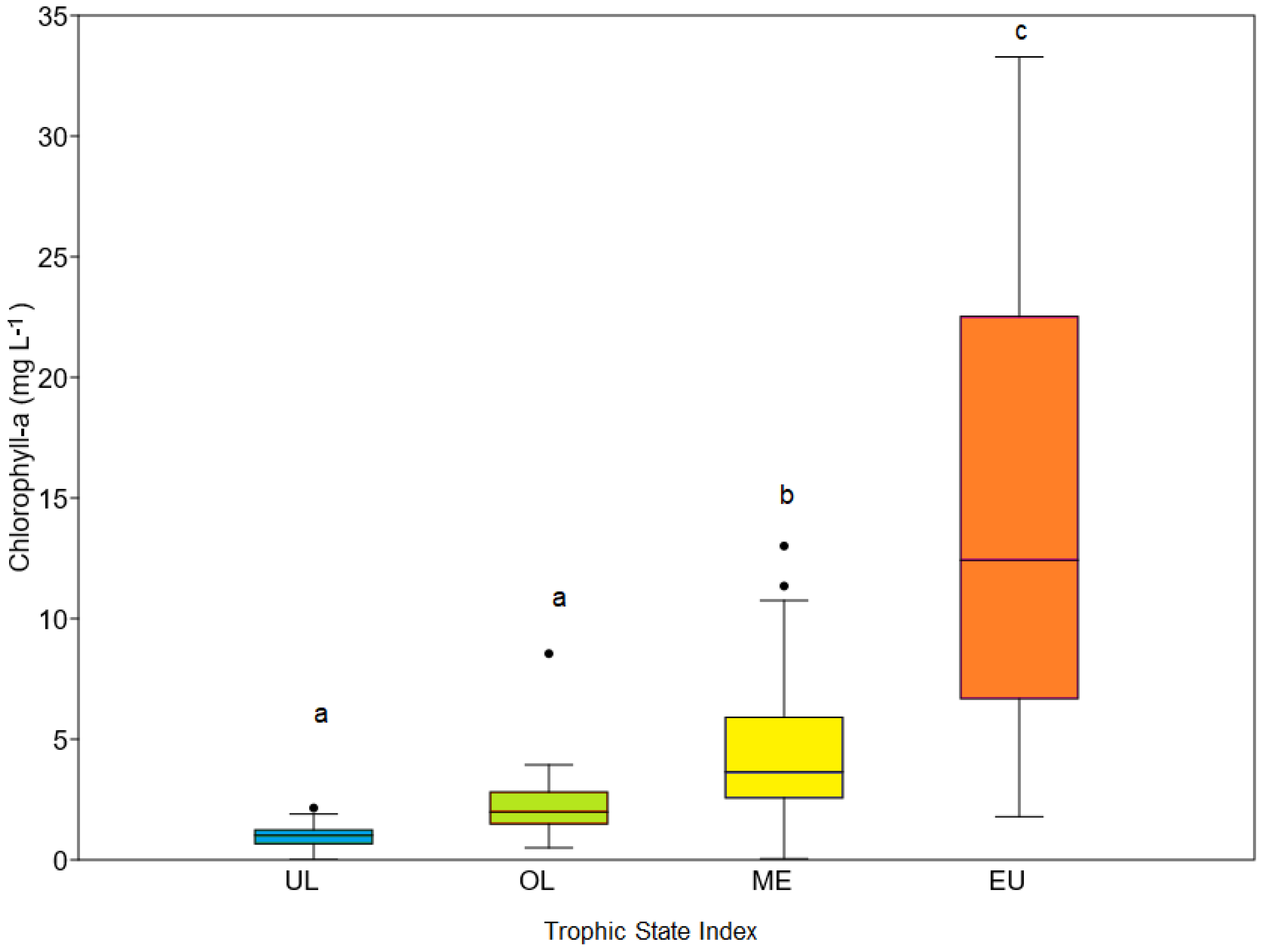
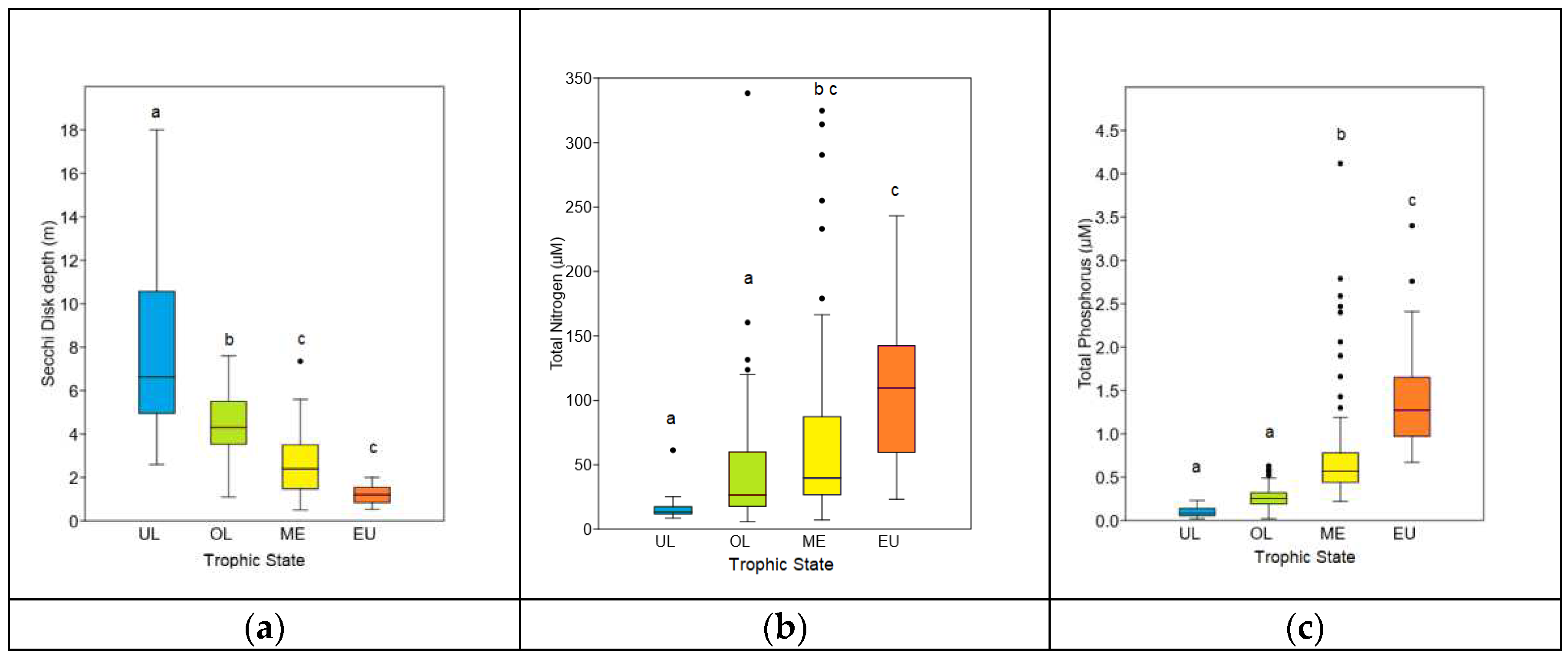
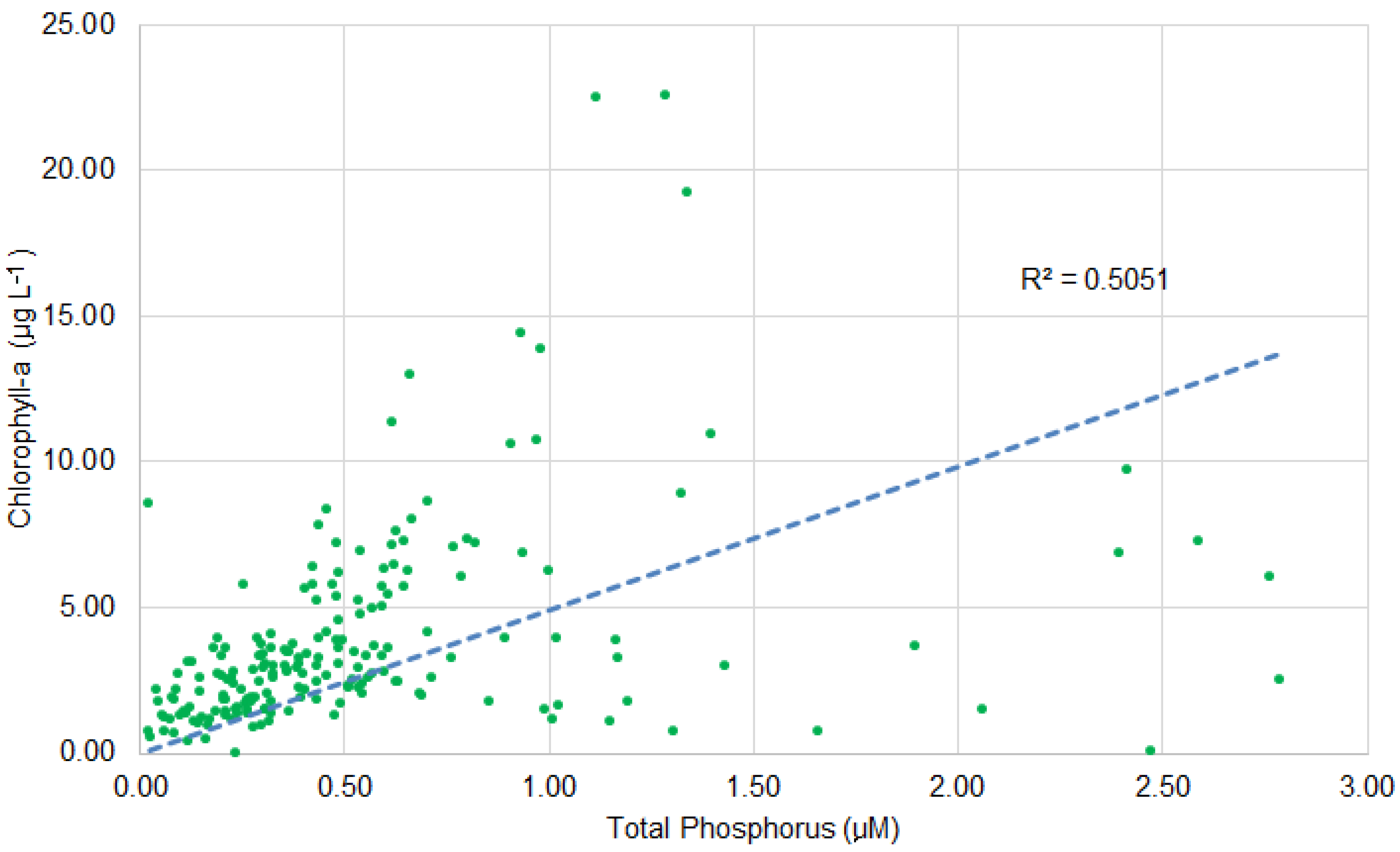
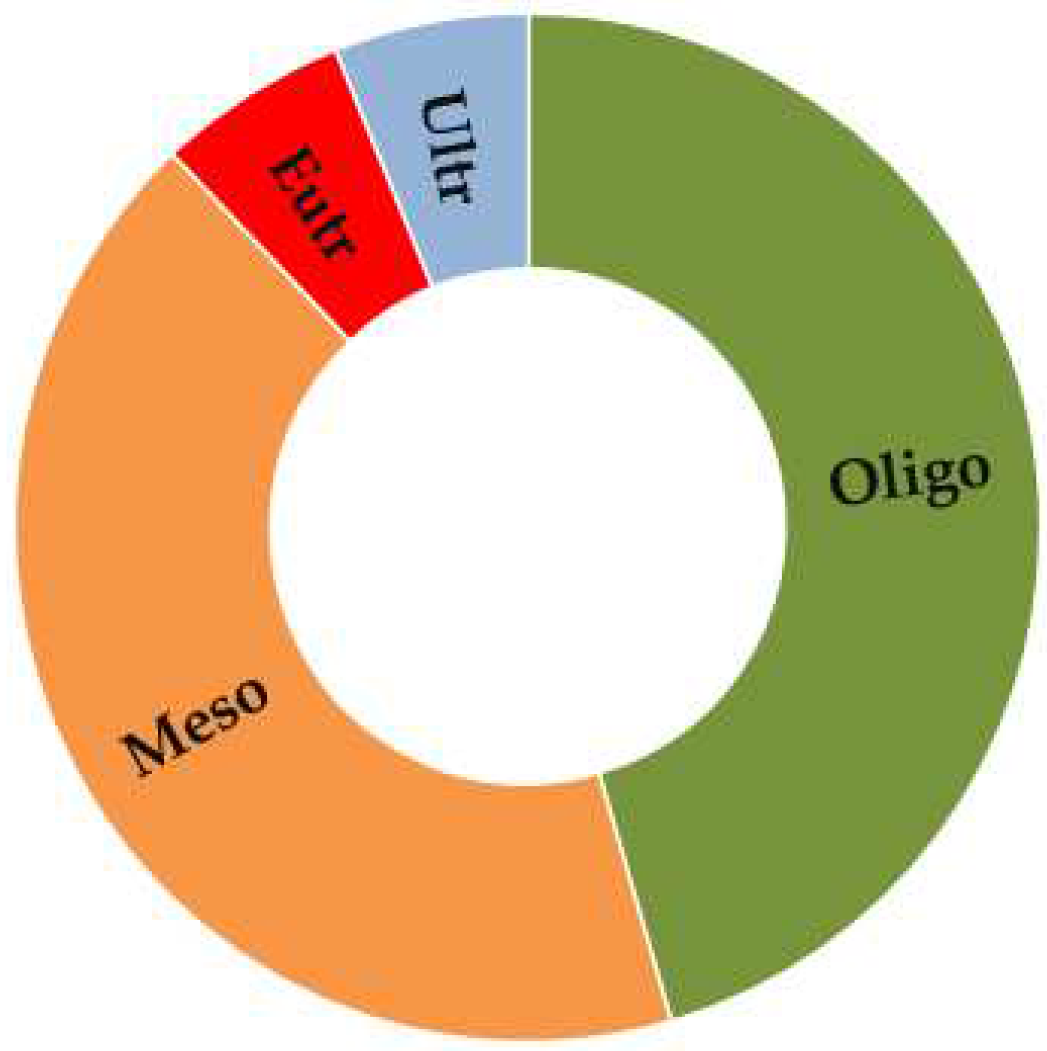
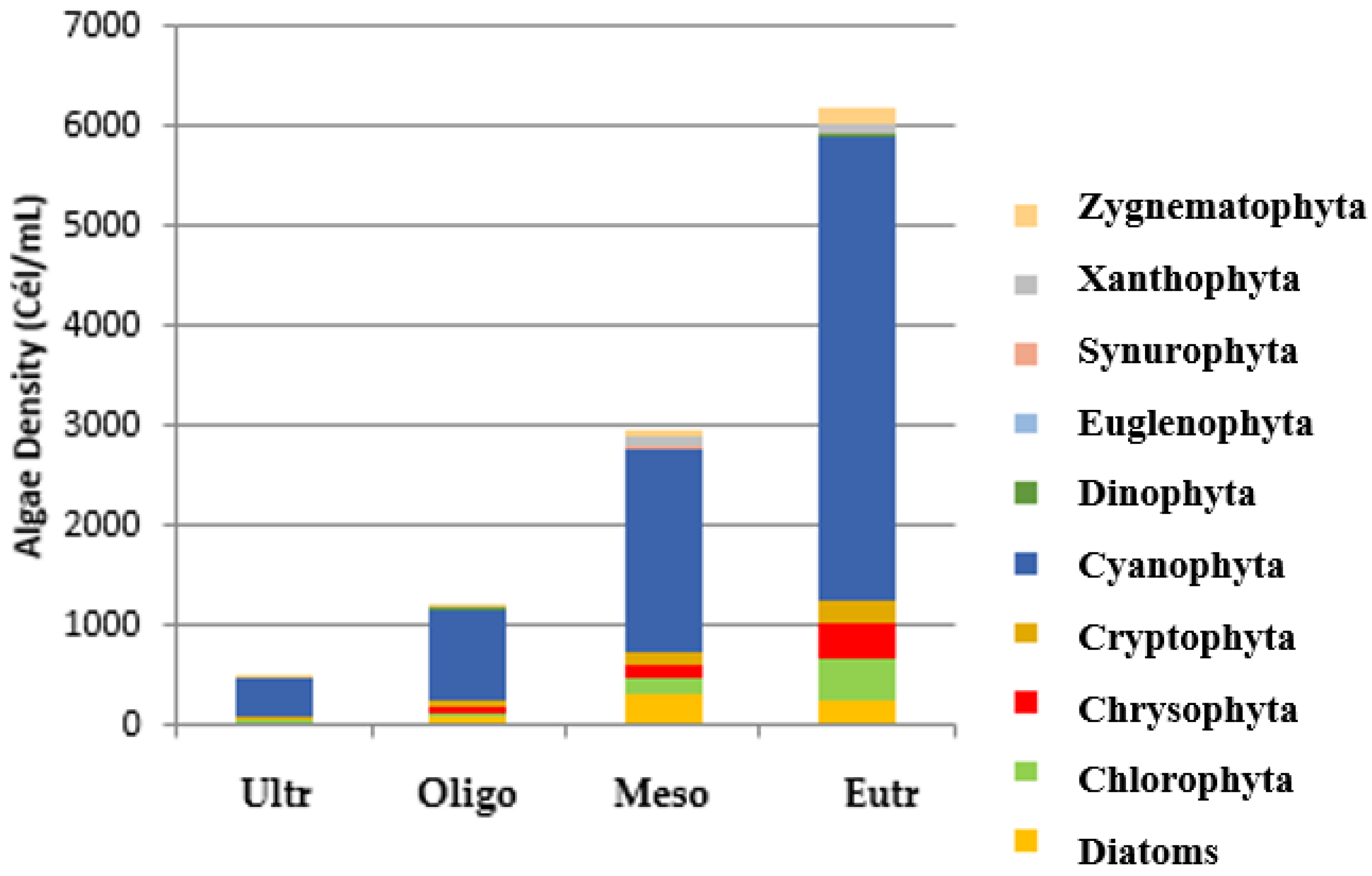
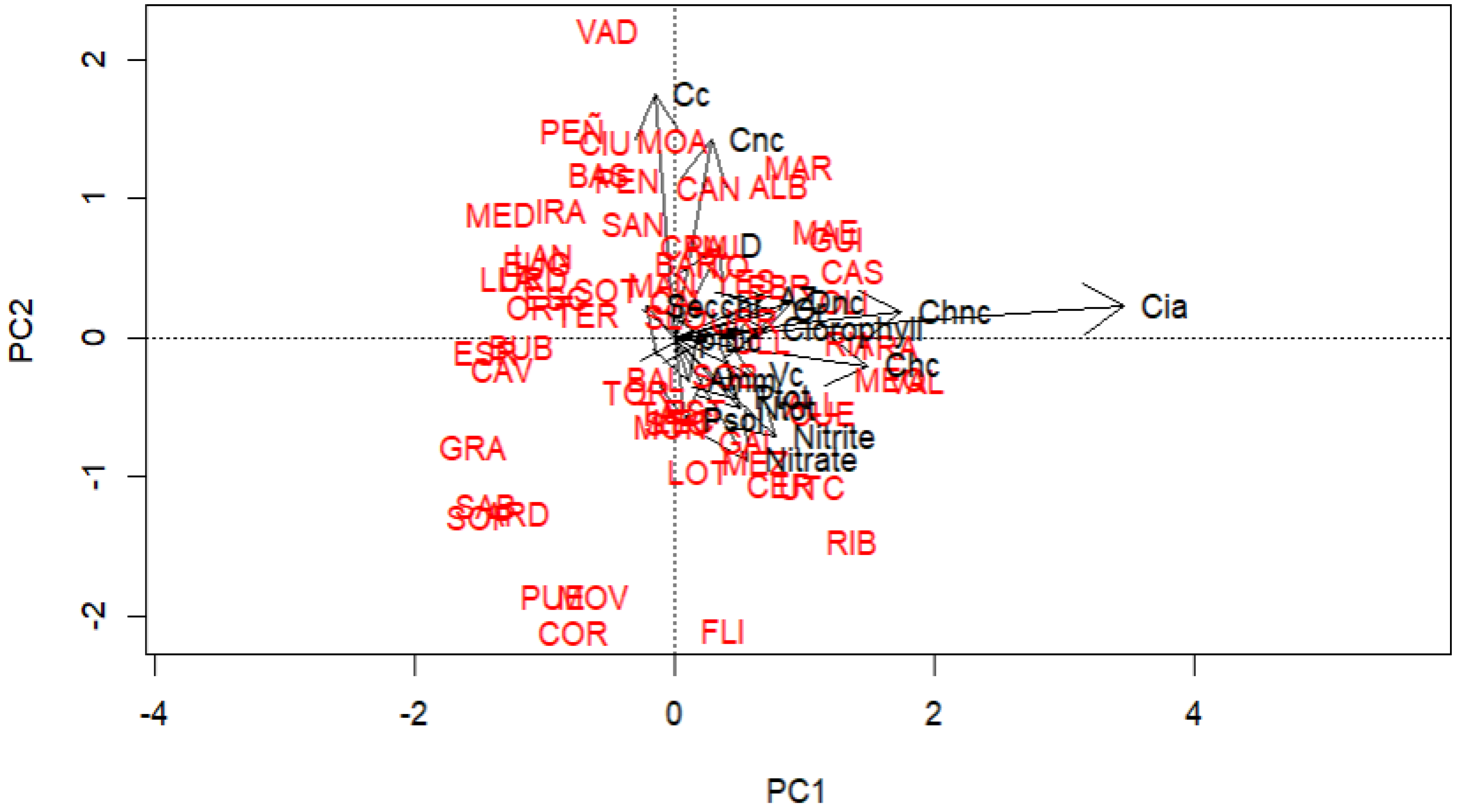
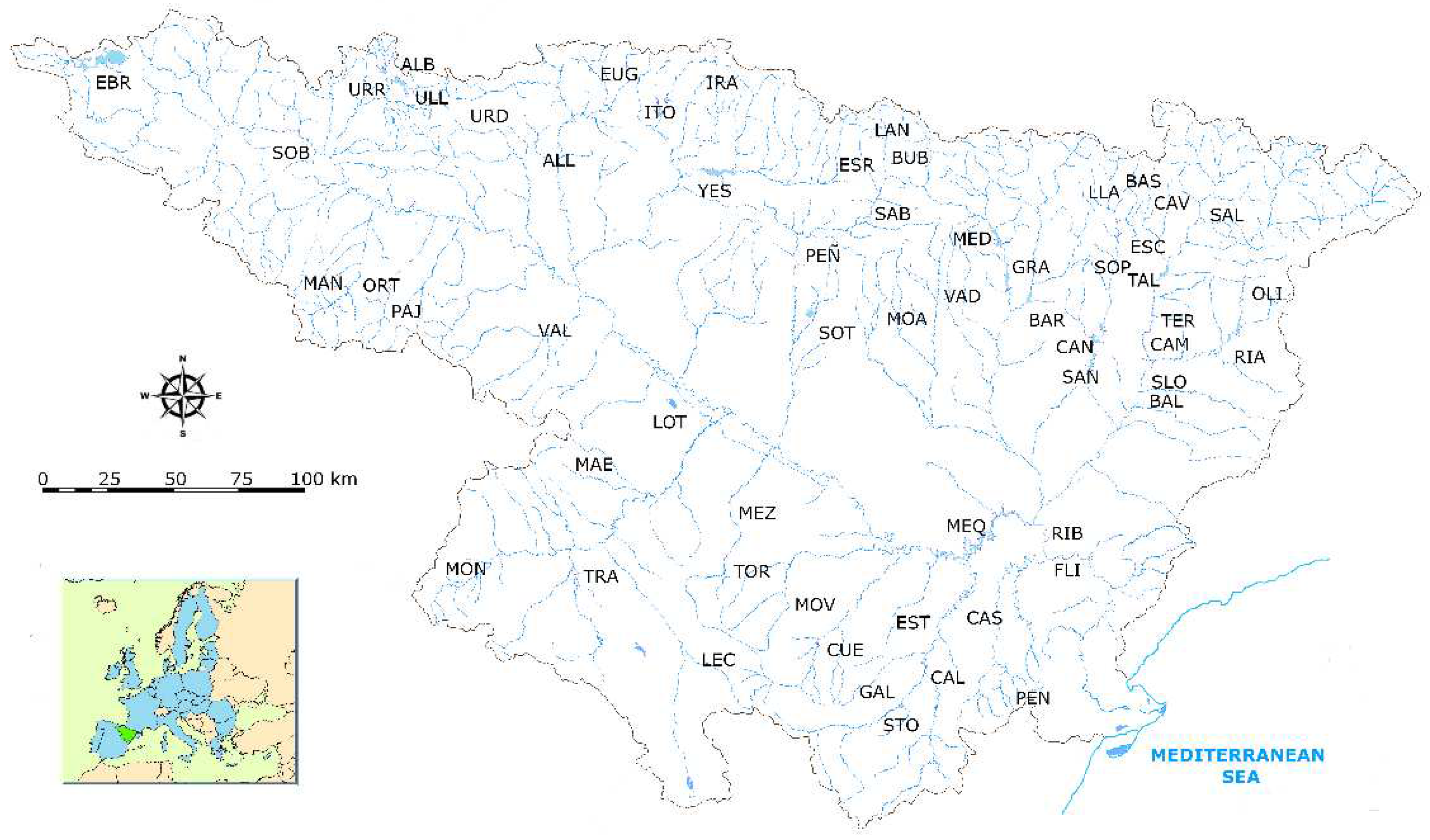
| FQ Variables | Mean | Max | Min |
|---|---|---|---|
| pH | 8.14 | 8.79 (El Val) | 6.90 (Cavallers) |
| Secchi Disc Values (m) | 4.13 | 18.00 (Cavallers) | 0.55 (Peña) |
| Anoxic Zone (m) | 2.72 | 38.00 (Mequinenza) | * |
| Nitrate (µM) | 37.47 | 308.16 (Torcas) | 0.04 (Ciurana) |
| Nitrite (µM) | 0.68 | 5.95 (El Val) | 0.01 (Pena) |
| Total Nitrogen (µM) | 53.28 | 325.78 (Torcas) | 8.58 (Escarra) |
| Ammonium (µM) | 2.22 | 17.26 (Moneva) | 0.09 (Pena) |
| Total phosphorus (µM) | 0.51 | 4.50 (Utchesa-Seca) | 0.02 (Baserca) |
| Soluble phosphorus (µM) | 0.11 | 2.64 (Cortijo) | 0.01 (Pena) |
| Chlorophyll a (µg/L) | 4.42 | 90.97 (Utchesa-Seca) | 0.01 (Sabiñanigo) |
Disclaimer/Publisher’s Note: The statements, opinions and data contained in all publications are solely those of the individual author(s) and contributor(s) and not of MDPI and/or the editor(s). MDPI and/or the editor(s) disclaim responsibility for any injury to people or property resulting from any ideas, methods, instructions or products referred to in the content. |
© 2023 by the authors. Licensee MDPI, Basel, Switzerland. This article is an open access article distributed under the terms and conditions of the Creative Commons Attribution (CC BY) license (http://creativecommons.org/licenses/by/4.0/).





